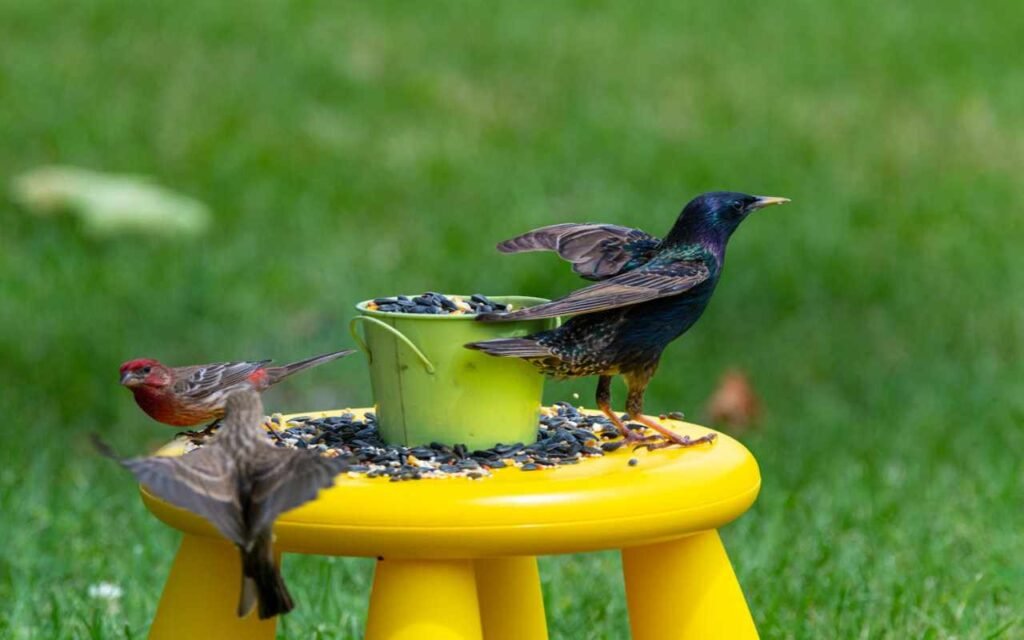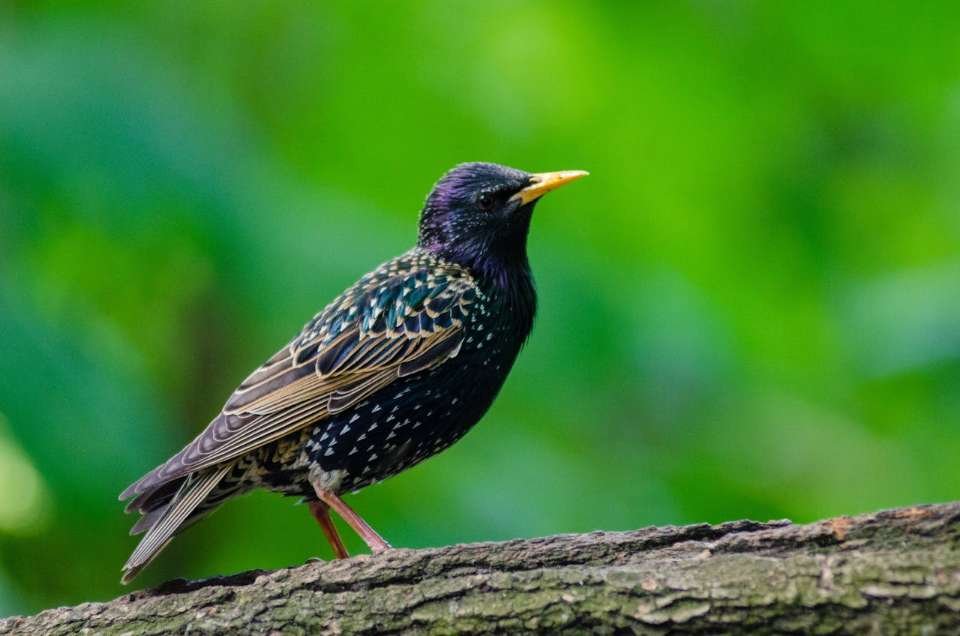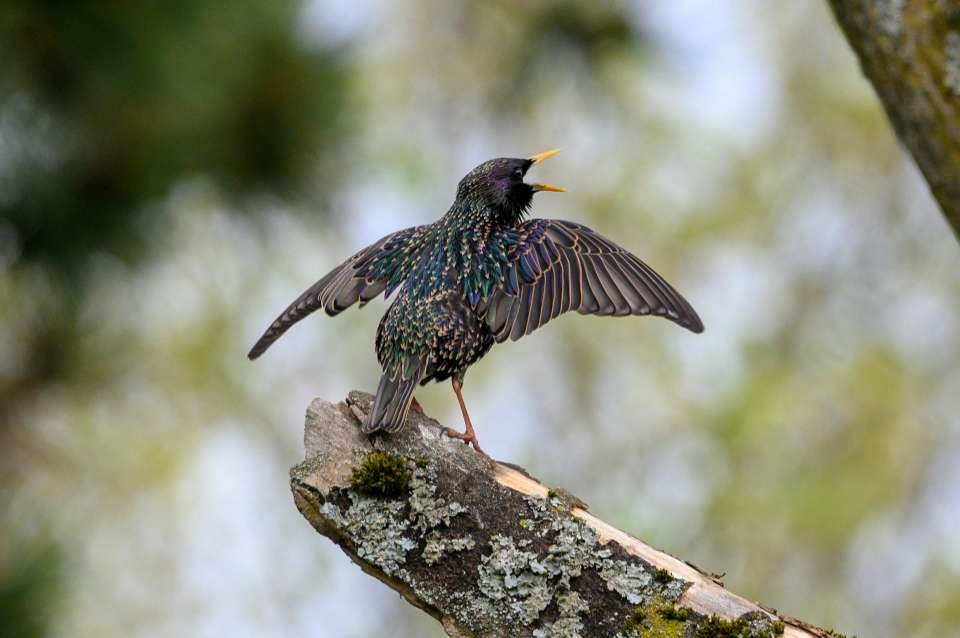You set out your brand-new bird feeder with premium seed, sit down with your morning coffee, and wait for cardinals and chickadees to arrive. Instead, a rowdy gang of starlings shows up, devouring everything like they’re at an all-you-can-eat buffet 😅. If you’ve been wondering how to deter starlings from bird feeders, you’re not alone.
I’ve been there, trust me. One minute I’m dreaming of peaceful backyard birdwatching, the next I’m watching these feathered bullies chase away every other bird while emptying my feeders faster than I can refill them. Starlings are notorious for monopolizing bird feeders, but here’s the good news: you absolutely can outsmart them with the right strategies.
Why Starlings Are Such Feeder Hogs
Let’s start with the elephant in the room, or should I say, the starling at the feeder. These birds didn’t earn their reputation as backyard bullies by accident. European starlings are incredibly aggressive and social, which means when one finds your feeder, the whole neighborhood gang shows up within minutes.
I learned this the hard way when I first started bird feeding. One lonely starling discovered my tube feeder on a Tuesday morning. By Thursday, I had what looked like a starling convention happening in my backyard every single day. They’d arrive in massive flocks, dominate the feeding area, and scare off the beautiful native birds I actually wanted to attract.
According to the Cornell Lab of Ornithology’s All About Birds, starlings frequently dominate bird feeders, arriving in large flocks and displacing more timid native songbirds.
The problem isn’t just their numbers, though that’s definitely part of it. Starlings are also incredibly persistent and adaptable. They’ll figure out how to access feeders that would stump other birds, and they’re not easily discouraged by minor obstacles. Plus, they eat pretty much everything, so switching seed types alone won’t solve your problem.
The Flock Mentality Problem
Here’s what makes starlings particularly challenging: they operate as a team. When you see one starling, you can bet there are dozens more nearby. They communicate with each other about food sources, which means your feeder essentially gets added to their daily restaurant rotation.
Ever notice how they seem to show up at the exact same time every day? That’s not coincidence. Starlings establish feeding routines and stick to them, which can actually work in your favor once you understand their patterns.
Feeder Design Solutions That Actually Work
The most effective way to deter starlings starts with choosing the right feeder design. Not all bird feeders are created equal when it comes to starling resistance, and I’ve tested enough of them to know which ones actually deliver results.
Weight-activated feeders are absolute game changers for starling control. These clever devices automatically close the feeding ports when heavier birds (like starlings) land on the perches. Most songbirds weigh significantly less than starlings, so they can still access the seed while the bullies get shut out.
According to the National Wildlife Federation, look for feeders with weighted perches or treadles: when a heavier bird lands, the treadle drops over the seed to block access, while lightweight birds can feed normally. They also suggest placing small bottles over extended perches on cagelike feeders, heavier birds roll off while lighter songbirds can feed safely.
Caged Feeders for Maximum Protection
Caged feeders surround your seed dispenser with a metal cage that allows smaller birds through while keeping larger, aggressive species out. I switched to a caged tube feeder about two years ago, and the difference was immediate and dramatic.
The key is getting the cage spacing just right. Too wide, and starlings will squeeze through. Too narrow, and you’ll accidentally exclude birds you want to attract. Look for cages with bars spaced about 1.5 inches apart for optimal results.
Upside-Down Suet Feeders
Here’s a trick that works brilliantly for suet lovers: upside-down suet feeders force birds to hang upside down while feeding. Native woodpeckers, nuthatches, and chickadees can do this easily, but starlings struggle with this feeding position and usually give up quickly.
I installed one of these last spring, and while my downy woodpeckers adapted within hours, the starlings took one look and moved on to easier targets. Sometimes the simplest solutions are the most effective.
Seed Selection Strategies
Want to know a secret that took me years to figure out? Starlings have very specific food preferences, and you can exploit this to your advantage. They absolutely love cracked corn, millet, and bread crumbs, but they’re much less enthusiastic about certain premium seeds.
Safflower seed is your secret weapon against starlings. Most native songbirds love it, including cardinals, chickadees, and house finches, but starlings find it bitter and unappetizing. I switched one of my feeders to pure safflower seed, and the starling visits dropped by about 80% within a week.
According to Wild Birds Unlimited, safflower seeds are widely recommended because most native songbirds enjoy them, while starlings, grackles, and squirrels typically avoid them. The hard shell of safflower seeds makes them difficult for starlings to eat, and using them exclusively in a feeder can help ensure your preferred birds get first dibs.
Nyjer Seed for Finch Feeders
If you’re trying to attract goldfinches and other small songbirds, nyjer seed (thistle seed) is another starling-resistant option. Starlings don’t typically bother with nyjer feeders, especially if you use tube feeders with small ports designed specifically for finch beaks.
The bonus here is that nyjer feeders attract some absolutely gorgeous birds that you might not see at regular seed feeders. American goldfinches, purple finches, and pine siskins all love nyjer, and they’re much more polite dinner guests than starlings.
What to Avoid Feeding
Here’s where I made some rookie mistakes early on. Avoid cheap seed mixes that contain lots of millet, cracked corn, and filler grains. These are like starling magnets, and you’re basically sending out engraved invitations to the neighborhood bully birds.
Bread crumbs are another no-go, even though they seem harmless. Starlings go absolutely crazy for bread, and once they associate your yard with easy carbs, you’ll never get rid of them.
Timing and Schedule Adjustments
This might sound a bit obsessive, but changing your feeding schedule can significantly reduce starling problems. I started paying attention to when the starlings showed up in my yard, and I discovered they had very predictable patterns.
Most starlings in my area arrive for breakfast around 7 AM and come back for an afternoon snack around 3 PM. So I started filling my feeders at different times and noticed fewer starling visits when I fed birds earlier or later than their established routine.
According to Holden Forests & Gardens, adjusting the types of food offered at different times of day can influence which bird species are attracted to your feeders, potentially helping to deter less welcome visitors.
The Empty Feeder Strategy
Here’s a slightly more aggressive approach that some birders swear by: temporarily remove feeders when starlings discover them. Leave them down for a week or two, then put them back up in different locations or with different seed types.
IMO, this works best if you coordinate with your neighbors. If everyone in the area removes feeders simultaneously, the starlings will be forced to find food sources elsewhere and might establish new routines that don’t include your yard.
Physical Deterrents and Modifications
Sometimes you need to get creative with physical modifications to existing feeders. I’ve had success with several DIY solutions that make feeders less starling-friendly without breaking the bank.
Adding shorter perches or removing perches entirely can help deter starlings while still allowing smaller birds to feed. Many songbirds can cling to feeding ports without needing large perches, but starlings prefer stable platforms for feeding.
Baffle and Guard Systems
Pole baffles aren’t just for squirrels – they can also discourage large flocks of starlings from congregating around your feeders. Large dome baffles placed above feeders make it difficult for multiple starlings to land and feed simultaneously.
I installed a clear dome baffle over one of my tube feeders, and while individual starlings could still access the seed, the large groups that used to overwhelm the feeder couldn’t coordinate their landing anymore.
Feeder Placement Tactics
Where you place your feeders matters more than you might think. Starlings prefer feeders in open areas where they can see potential threats approaching. They’re actually pretty paranoid birds, which you can use to your advantage.
Try moving feeders closer to dense shrubs or trees where smaller songbirds feel comfortable but starlings feel exposed. This works particularly well if you have cats in the neighborhood – starlings are more cautious about feeding in areas where predators might be hiding.
Natural Deterrent Methods
Let’s talk about some gentler approaches that work with starling behavior rather than against it. Creating alternative feeding areas away from your main bird feeding station can help redirect starling attention while still providing food for wildlife.
I set up a basic platform feeder about 50 feet from my main feeding area and stock it with cracked corn and cheap seed mix. This gives the starlings what they want while protecting the premium feeders I’ve set up for native songbirds.
Habitat Modifications
Starlings love large, open lawns where they can forage for insects and grubs. Reducing the amount of short, manicured grass in your yard can make your property less attractive to starling flocks looking for foraging opportunities.
This doesn’t mean you need to let your yard turn into a jungle, but allowing some areas to grow a bit longer or adding more diverse plantings can shift the bird demographics in your favor.
Encouraging Natural Predators
Here’s something that might surprise you: encouraging birds of prey in your area can help control starling populations. Hawks and falcons view starling flocks as convenient fast food, and their presence alone can discourage large groups from hanging around.
You can attract raptors by providing tall perches like dead trees (if safe) or installing hawk perches. Just be aware that this might also affect other bird species you want to attract.
According to the University of Wyoming Extension, building raptor perches where appropriate provides a corridor for raptors to become more active on a landscape, helping to naturally balance local bird populations.
Advanced Starling Management
For persistent starling problems, you might need to combine multiple strategies for maximum effectiveness. I call this the layered defense approach, and it’s what finally gave me the upper hand in my ongoing starling battles.
Start with starling-resistant feeders, switch to less preferred seed types, modify your feeding schedule, and add physical deterrents. Most starlings will get discouraged and move on to easier targets when faced with multiple obstacles.
Working with Neighbors
This is where community cooperation really pays off. Coordinating starling management efforts with your neighbors multiplies the effectiveness of any strategy you try. If everyone on the block makes feeding more difficult for starlings, they’ll likely relocate to areas with easier pickings.
I organized an informal neighborhood chat about bird feeding, and we discovered that three houses were unknowingly creating a starling paradise with easy access to food. Once everyone adjusted their approach, the entire area saw fewer problematic starling flocks.
Monitoring and Adjusting
Don’t expect to solve your starling problem overnight. Effective starling management requires patience and willingness to adjust your approach based on what you observe. Keep track of which methods work best in your specific situation and be prepared to modify your strategy.
I keep a simple log of which feeders get the most starling attention and which seem to deter them effectively. This helps me make informed decisions about future feeder purchases and placement strategies.
Common Mistakes to Avoid
Let me save you some time and frustration by sharing the biggest mistakes I see people make when trying to deter starlings. The number one error is giving up too quickly. Starlings are persistent, and they’ll test your defenses repeatedly before moving on to easier targets.
Another common mistake is trying to solve the problem with just one approach. Single-strategy solutions rarely work long-term with starlings because they’re intelligent and adaptable. You need multiple deterrents working together for lasting results.
Don’t Feed Them Accidentally
This seems obvious, but you’d be surprised how many people unknowingly create starling attractants. According to NestWatch, House Sparrows prefer smaller seeds like millet, cracked corn, and milo, which are plentiful in inexpensive bird seed mixes, while European Starlings like premium black-oil sunflower seeds.
Spilled seed under feeders, easily accessible suet, and platform feeders with these seed types all attract unwanted species. NestWatch recommends offering foods that these birds do not appreciate, such as safflower for cardinals, nyjer for finches, and nectar for hummingbirds, and avoiding scattering seed on the ground. Feeders with short perches and small ports are also less attractive to these species.
Regular cleanup under feeders and choosing appropriate feeder styles for your goals makes a huge difference in the types of birds you attract.
The Bottom Line
Dealing with starling invasions at your bird feeders doesn’t have to ruin your backyard birding experience. The key is understanding starling behavior and using multiple strategies that work together to make your feeders less attractive to these aggressive birds while still welcoming the species you want to see.
Remember, this is an ongoing process, not a one-time fix. Starlings are smart, adaptable, and persistent, so you need to be equally committed to your deterrent strategies. But trust me, watching a peaceful cardinal enjoy breakfast without being bullied by a gang of starlings makes all the effort worthwhile 🙂
The most successful approach combines the right feeder designs, appropriate seed choices, strategic timing, and a bit of patience. Start with one or two methods that appeal to you, then add additional deterrents if needed. Before you know it, you’ll have reclaimed your feeders and created the peaceful bird sanctuary you originally envisioned.





